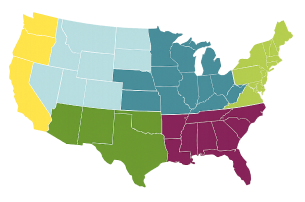All About Bee Balm
Posted By American Meadows Content Team on Mar 1, 2017 · Revised on Oct 3, 2025

Knowing your location helps us recommend plants that will thrive in your climate, based on your Growing Zone.
Posted By American Meadows Content Team on Mar 1, 2017 · Revised on Oct 3, 2025

Bee balm has long been a favorite of temperate gardens in America and Europe, but in recent years it has surged in popularity as the desire to plant beautiful and functional American natives increases across the nation. There are few joys as great as working around bee balm in the summer and being kept company by the citrusy, resonant scent of foliage and flower; unless of course it’s witnessing the honey bees and hummingbirds jockeying for position around the unusual, two lipped flowers shaped like little crowns.
Those flowers are borne on the end of square-stemmed stalks that can rise up to 4 ft above the main foliage. Blooms come in an array of colors, from pinks to reds to purples to white, and flower in mid-summer with other garden favorites such as phlox, liatris and daylilies. Foliage is oval and serrated and has a rough texture.
If deadheaded, bee balm will continue to re-bloom until late summer, when the gardener may wish to leave the seed heads for hungry birds during the winter months.
Bee-balm couldn’t be easier to grow. Select a sunny site with soil that is rich in organic matter to provide moisture retention and good drainage. While bee balm can cope with soils of average fertility, dry soil for a sustained period of time will cause the plant to weaken and die. Mulching your plant with two inches of organic-based mulch will go a long way towards preserving the moisture between rain and watering by the gardener, especially as bee balm is shallowly rooted.

If you’re growing a larger cultivar, be sure to give it adequate spacing in the bed, placing individual plants 18-24 inches apart. Don’t worry, bee balm is a fast grower and those gaps between plants will soon be filled. Dwarf cultivars that reach heights of 15-18 inches are well placed in the front of a garden bed or border, or for creating an unusual container combination for the deck.
Bee balm is in the mint family and as such, will spread aggressively via underground stolons (creeping stems). For this reason it’s not a good bed-fellow for smaller, more delicate plants. Pair it instead with a hefty Shasta daisy or alongside Rudbeckia, Sedum, or Phlox, which will set off its blooms but will set boundaries.
Many gardeners appreciate this spreading characteristic, as it means lots of favorite plants to share with other gardeners – and that shallow root system makes it easy to do. For older plants, dig it up, discard the woody center, and make small divisions of the newer shoots and roots. Even a small piece will become a good-sized plant in a season. For younger plants, you can simply shave off pieces with a sharp spade, keeping the plant in bounds and giving yourself more stock. Regardless of how you do it, a stand of bee balm will need to be divided after three years as it’s prone to overcrowd itself and weaken.

Bee-balm is known for becoming a martyr to powdery mildew, which appears later in the summer and will disfigure foliage, diminishing the overall appearance of the plant. But there are methods gardeners use to avoid it. First, planting cultivars that are fairly resistant, which is usually stated in specific plant profiles. Second, siting your plants where they have plenty of ventilation. Third, using organic fungicides when conditions start to favor mildew (heat and humidity), but before the plant shows signs of it.
Employing two, or all three of these methods can ensure beautiful plants that continue to provide blooms into the early days of autumn.
A finely scented tea can also be made from the foliage. In Revolutionary America it was cultivated and used when colonists were unable to purchase black tea. The tea was named ‘Oswego Tea’ after the river and area in upstate New York where Native Americans collected it for that purpose, amongst others. But it is not, as many think, used to create oil of bergamot – the main flavoring in the British favorite Earl Grey.
Bergamot is another common name for bee balm, but is misleading. Certainly, the strong, citrusy fragrance emanating from bee balm bears more than a passing resemblance to a steaming cup of Earl Grey, but bergamot oil comes from a citrus fruit, not this cottage garden favorite. It is likely that this name was given to bee balm due to the resemblance (which is why botanists and horticulturalists have such a good case for using Latin names when it comes to plants).
But there is even more to this plant, used medicinally by the Native Americans for centuries. It has anti-septic properties as it contains a high proportion of thymol, and is used in poultices in the treatment of wounds. It is also said to be helpful for the treatment of nausea and depression.

Consider siting bee balm in a traditional herb or medicinal garden, or just as a beautiful addition to a small front bed. This summer I sat entranced in a bed of canna and scarlet ‘Jacob Cline’ bee balm while the hummingbirds, butterflies and bees all came to partake in the riot of color and nectar above me. I was supposed to be weeding, but nobody knew that but me. Bliss.
About the Author: Marianne Willburn is a columnist, blogger and author of the new book "Big Dreams, Small Garden: Creating Something Extraordinary in Your Ordinary Space." Originally from California, she now gardens in Virginia – read more at www.smalltowngardener.com.
To learn more about the plants we sell and how to grow them in your garden beds and patio containers, sign up for our inspiring emails.